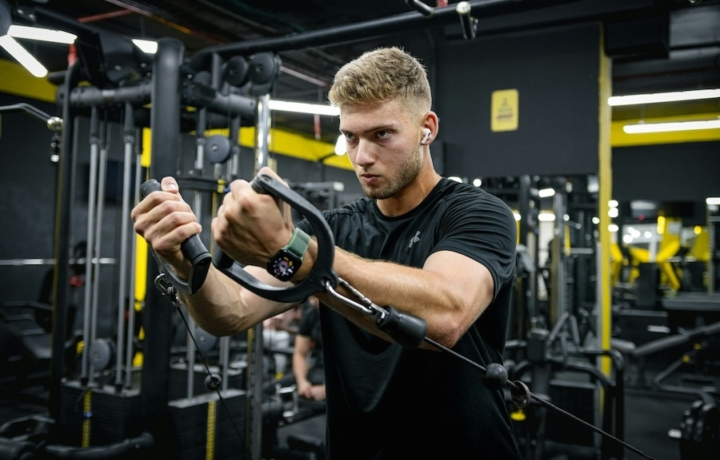Exercise
Cable Low to High Cable Fly

Cable Low to High Cable Fly
How to Perform
- Adjust the cable pulleys to the lowest position and select an appropriate weight for your level, then stand in the center of the cable machine with your feet shoulder-width apart and your core engaged.
- Grasp a handle in each hand and step forward slightly, maintaining a slight bend in your knees and a neutral spine position.
- Begin with your arms extended down and slightly in front of your body, with a slight bend in your elbows and palms facing forward.
- Brace your core and exhale as you pull the cables upward and inward in a wide arc motion, bringing your hands together at about eye level.
- Keep your elbows slightly bent throughout the movement, maintaining the same angle from start to finish to maximize chest engagement.
- At the top of the movement, squeeze your chest muscles for 1-2 seconds while maintaining proper posture and avoiding excessive leaning backward.
- Inhale as you slowly return to the starting position in a controlled manner, following the same arc path and feeling the stretch across your chest.
- Maintain tension on the cables throughout the entire exercise, never allowing the weight stack to rest between repetitions.
Important information
- Avoid locking your elbows at any point during the exercise as this shifts tension away from the chest muscles and can stress the joints.
- Focus on moving your arms in an arc pattern rather than a straight line to properly engage the chest fibers.
- Keep your shoulders pulled back and down throughout the movement to prevent unnecessary strain on your shoulder joints.
- If you feel excessive strain in your shoulders rather than your chest, reduce the weight and check your form before continuing.

Cable Low to High Cable Fly
Exercise Details
Primary Muscles
Muscle Groups
Mechanic
Risk Areas
Built for progress
Take the guesswork out of training
Create personalized AI-powered workout plans that evolve with you. Train smarter, track every rep and keep moving forward, one workout at a time.






The Cable Low to High Fly is an effective chest exercise that helps build strength and shape in your upper body. It mainly targets the chest muscles, with extra activation in the front of the shoulders. Because multiple muscles work together during the movement, it’s a smart choice for developing overall upper-body strength and control. Unlike traditional flat bench chest flies, the low-to-high angle creates unique muscle activation patterns across the pecs, particularly emphasizing the upper and inner portions. This trajectory mimics the natural movement pattern of bringing your arms together against resistance, which makes it biomechanically sound for most physiques and shoulder structures.
For bodybuilding enthusiasts, this exercise offers exceptional value in creating that sought-after chest separation and definition. The constant tension provided by the cables throughout the entire range of motion stimulates both fast and slow-twitch muscle fibers, promoting balanced development and improved mind-muscle connection in the chest region. While primarily considered a hypertrophy exercise, the Cable Low to High Fly contributes significantly to functional strength development. The stabilization required throughout the movement engages core musculature and improves shoulder joint integrity, translating to enhanced performance in pressing movements like bench press and push-ups.
Program this exercise strategically in your training split: it works excellently as a finisher after heavy compound movements when the chest fibers are already fatigued. Alternatively, use it as a pre-exhaust technique before pressing exercises to maximize pectoral recruitment. Many advanced lifters also incorporate it into superset protocols to amplify training density and metabolic stress.
The beauty of cable exercises lies in their adjustability. As your strength increases, simple weight progression allows continued challenge without the awkward jumps sometimes experienced with dumbbell alternatives. This makes the Cable Low to High Fly an excellent choice for consistent progression in your chest development journey, regardless of whether you're training primarily for aesthetics or functional strength.
FAQ - Cable Low to High Cable Fly
The Cable Low to High Fly primarily works the pectoral muscles, with emphasis on the upper and inner chest regions. It also engages the anterior deltoids (front shoulders) as secondary movers and recruits core muscles for stabilization throughout the movement.
Stand facing the cable machine with a staggered stance for stability, keep your upper arms close to your ears throughout the movement, and focus on extending only at the elbow joint while maintaining a stable torso. The movement should come solely from your elbows, not your shoulders or back.
Increase the resistance gradually as you master the movement pattern. Try slowing down the eccentric (lowering) phase to 3-4 seconds, incorporate brief isometric holds at the point of maximum contraction, or perform drop sets by immediately reducing weight when you reach failure for extended time under tension.
Unlike flat bench flies that move horizontally, the Low to High Cable Fly's diagonal movement pattern creates unique activation across the upper chest fibers. The cable mechanism also provides constant tension throughout the entire range of motion, whereas dumbbells lose resistance at certain points of traditional flies.
Incorporate this exercise 1-2 times weekly as part of your chest training. Position it after compound movements like bench press or as part of a superset to maximize muscle fiber recruitment. For hypertrophy, aim for 3-4 sets of 10-15 reps with moderate weight and focus on maintaining perfect form.








